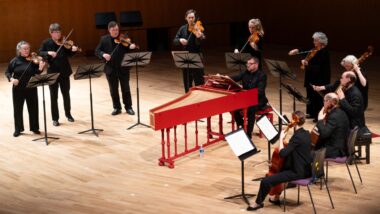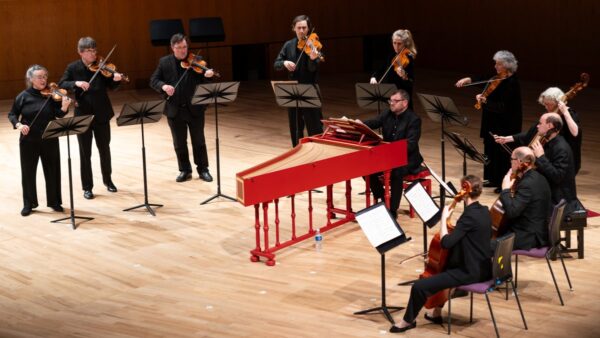 United Kingdom Bach: Orchestra of the Age of Enlightenment. Queen Elizabeth Hall, London, 13.11.2024. (CK)
United Kingdom Bach: Orchestra of the Age of Enlightenment. Queen Elizabeth Hall, London, 13.11.2024. (CK)

Bach – Brandenburg Concerto No.1; Brandenburg Concerto No.3; Brandenburg Concerto No.5; Brandenburg Concerto No.4; Brandenburg Concerto No.6; Brandenburg Concerto No.2
For me, and doubtless for thousands of others, Bach’s Brandenburg Concertos were the gateway to the Baroque: I vividly remember the Saga LPs that I pretty much wore out during my teens in the Sixties (along with the Beatles and the Rolling Stones). Yet I have heard them in concert only rarely, and singly: never, before this musical feast laid on by the Orchestra of the Age of Enlightenment, had I heard the whole set in a single evening.
The Queen Elizabeth Hall was packed: and this was only a staging post in a tour that is bringing Bach to venues of all shapes and sizes from Manchester to Malvern, from Oxford to Darlington, from Stamford to Saffron Walden – the programme flexibly adapted to the size and nature of each venue. So it is a safe bet that dozens – no, hundreds – of people will be delighted to encounter the Brandenburgs and drawn in to explore the riches of the Baroque beyond them.
And what a delight they were. With the OAE playing one to a part (with no conductor) the sound was small but transparent, each instrument crystal clear. There were acres of bare space around the smaller groupings on the Queen Elizabeth Hall stage: it may well be that other venues will make a better acoustic fit for the music – it would be very interesting to hear the players’ view on this at the end of the tour. One of the chief pleasures of the evening was the variety of instruments and sonorities on display: Bach is as endlessly inventive in his use of different combinations (no two concerti are alike) as he is in the music he writes for them.
The concerti were not played in numerical order (odd-numbered before the interval, even-numbered after), but No.1 got us off to a fine start: as much fun visually as musically, with the corni da caccia (Ursula Paludan Monberg, Martin Lawrence) flanking the centrally-placed harpsichord and held in front of the body with the bell pointing aloft, above the player’s head. There was drama too: during the pre-concert discussion we had been alerted to the fact that the horns act as disrupters, musical anarchists, only gradually brought into consonance with the other players.
Yet the corni da caccia (hunting horns) are not the real stars here: that accolade goes to the silvery sound of the rare piccolo violin (Huw Daniel), twining beautifully with the oboe in the Adagio and emerging in the ensuing Allegro as a soloist in its own right. This is the only Brandenburg to sport a fourth movement, a Minuet – as if Bach were treating it as a set of dances, as he was to do in his suites. The first Trio was especially beautiful, a pair of oboes duetting suavely and deliciously over a discreetly tramping bassoon; the second Trio (Bach inserts a Polacca between them) produced wonderfully agile and exuberant playing from the horns – a good playout for them, since this is their sole appearance in the set.
A lovely contrast, then, to hear strings alone – three each of violins, violas and cellos – in the Third Concerto: one player to a part creating a wonderfully detailed tapestry of sound. In the concluding Allegro they sounded like a hive of bees: and the two chords of the Adagio were elaborated in attractively improvisatory style by the leader – the well-named Margaret Faultless – accompanied by Stephen Devine on harpsichord.
Devine came into his own in the crazy cadenza that radically extends the opening movement of the Fifth Concerto: but even though the harpsichord was moved to the front of the stage, lid up and angled as a concert grand would be, it was a feat of concentration for the listener as well as the player. The Affettuoso was played by flute, violin and harpsichord with flexibility and feeling; the concluding Gigue was as jaunty as you like. It was moving to notice later that the OAE’s transverse flute player also played in Trevor Pinnock’s earlier recording with The English Concert: what a wonderful span of Bach performance!
The Fourth Concerto (after the interval) was an absolute joy. Violin fireworks (Huw Daniel), burbling recorders with an infectious lilt; in the Andante, a genteel conversation between recorders and strings; and a Presto fugal finale with an irresistibly madcap air. My Baroque-loving friend Tim is of the opinion that the Brandenburgs should dance: this one certainly did. And then how wonderful to see a pair of violas da gamba take the stage, along with two violas and continuo for the Sixth Concerto: the violas da gamba behaving with impeccable manners while the violas chased each other in close canonic imitation. The Adagio, before the busy concluding Gigue, was as gravely beautiful as the famous slow movement of the Concerto for two violins.
Placing the Second Concerto last suggested (to me, with very little experience of Baroque practice) that the concert would culminate in trumpet thrills: yet David Blackadder’s playing was carefully in scale with the other instruments, a part of the texture rather than a star turn. I mean no disrespect to him in saying that the lovely interplay between recorder, violin and oboe in the central Andante gave me most pleasure.
So many beauties of sound, so many varieties of timbre and texture: for two hours the hall was full of noises, sounds and sweet airs, that charm the ear and hurt not. I almost felt like volunteering as a roadie so that I could join the tour and hear this music again and again.
Chris Kettle
